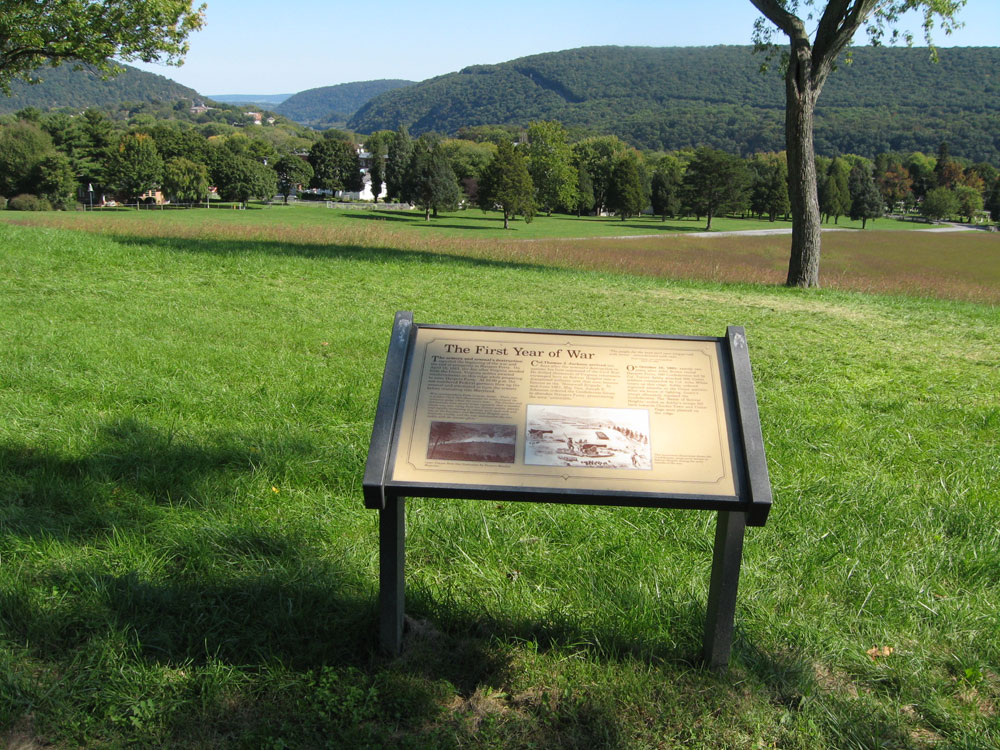Harpers Ferry Main • Tour the Battlefield > Bolivar Heights
The First Year of the War wayside marker is on the east side of the loop about 60 yards south of the trailhead on the Union Battle Line Loop Trail on Bolivar Heights in Harpers Ferry National Historical Park. The trailhead is west of Harpers Ferry at the intersection of Whitman Avenue and Prospect Avenue immediately next to the parking area.

Looking east past the marker toward the town of Harpers Ferry and the confluence of the Potomac and Shenandoah Rivers in the valley beyond. Directly ahead in the distance are the Loudoun Heights and on the left Maryland Heights.
From the marker:
The First Year of the War
“The people for the most part were tongue-tied with terror…overwhelmed with ruin…”
Porte Crayon, war correspondent
April 18, 1861
The armory and arsenal’s destruction signaled the beginning of the war and the end of prosperity in Harpers Ferry. On April 18, 1861, the day after Virginia seceded from the Union, Virginia militia awaited reinforcements on this ridge while preparing to seize Harpers Ferry. At 10:00 p.m. the out-numbered Federal garrison blew up the arsenal and attempted to burn the armory before retreating into Maryland.
War correspondent Porte Crayon, wrote: “There was a sudden flash that illuminated for miles around the romantic gorge where the rivers meet…. The flashes and detonations were several times repeated; then a steadier flame was seen rising from two district points, silently and rapidly increasing in volumes until each rock and tree on Loudoun and Maryland Heights were distinctly visible, and the now overclouded sky was ruddy with the sinister glare.”
Col. Thomas J. Jackson arrived ten days after the arsenal’s destruction to assume his first command of the Civil War. He drilled thousands of Virginia volunteers encamped here on Bolivar Heights into a disciplined military unit that soon became famous as the “Stonewall Brigade.” In mid-June 1861, Maj. Gen. Joseph E. Johnston ordered the Confederate forces to abandon Harpers Ferry, pronouncing the area “untenable.”
On October 16, 1861, exactly two years after John Brown raided Harpers Ferry, 500 Confederates led by Col. Turner Ashby attacked 600 Union soldiers commanded by Col. John White Geary on this ridge. Ashby ordered repeated assaults on the Union position. After six hours of fighting, Geary’s troops ultimately repulsed the Confederates. The “Battle of Bolivar Heights” ended as Ashby’s troops fell back toward Charles Town and Union flags were planted on the ridge.
Caption to the larger illustration:
This eyewitness illustration shows the Confedertates using naval cannon on Bolivar Heights during the early months of the war.
Caption to the smaller illustration:
Later, Crayon drew this illustration for Harpers Monthly Magazine.
Porte Crayon was the pen name for David Strother, a native of Martinsburg, (West) Virginia who was a well-known illustrator before the war, contributing to magazines such as Harpers Weekly. With the start of the war Strother remained loyal to the Union and was commissioned a Union officer.

